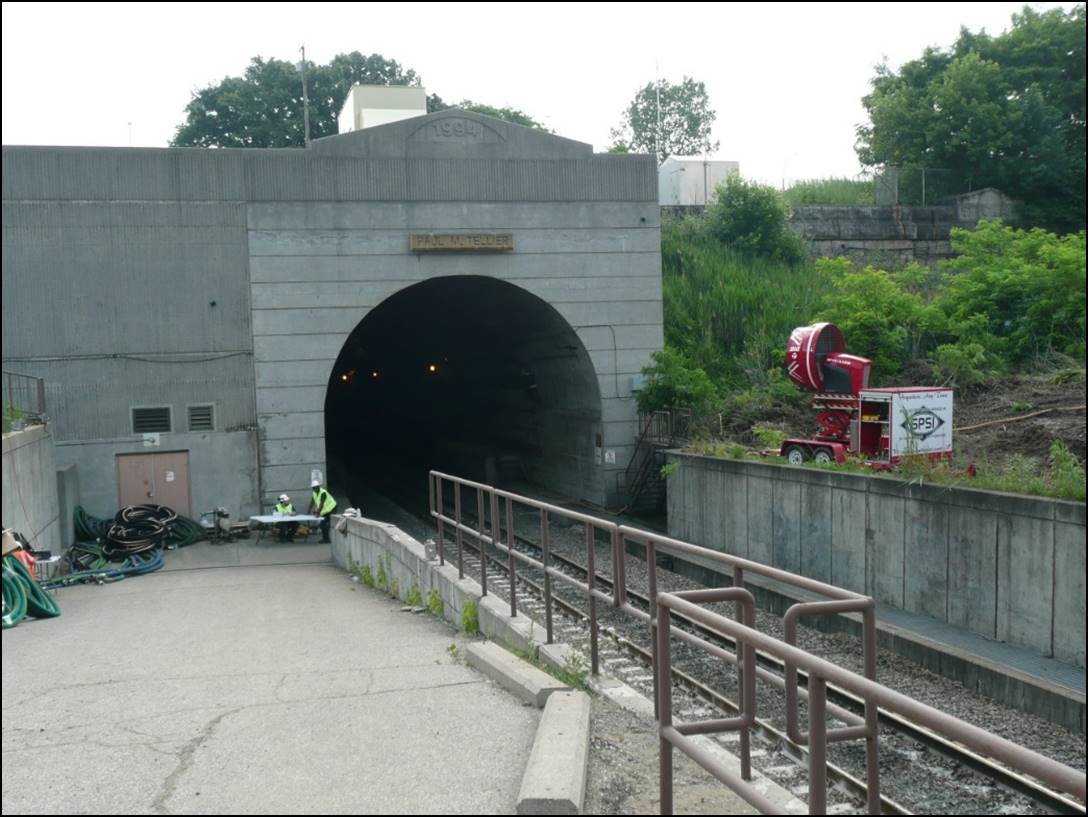Train inspection following a derailment with dangerous goods in a tunnel
Place du Centre
200 Promenade du Portage
4th Floor
Gatineau QC K1A 1K8
19 August 2019
617-08/19
R19T0107
Director General, Rail Safety
Transport Canada
14th Floor, Enterprise Building
427 Laurier Avenue
Ottawa, Ontario
K1A 0N5
Re: Rail safety advisory letter 08/19
Train inspection following a derailment with dangerous goods in a tunnel
On 28 June 2019, westbound Canadian National Railway (CN) freight train M38331-27 (the train) was a key train operating on the CN Strathroy Subdivision, which is a key route. The train consisted of 2 head-end locomotives, 1 mid-train distributed power (DP) remote locomotive (situated between the 81st and 82nd car) and a total of 140 cars, including 125 loaded cars, 12 empty cars, and 3 residue cars. The train was 9541 feet long and weighed 15 674 tons.
The Strathroy Subdivision consists of a single main track that extends from Mile 0.0 (London, Ontario) to Mile 61.7 (Port Huron, Michigan, United States) where it joins Mile 334.2 of the CN Flint Subdivision. Train movements are governed by the centralized traffic control system method of train control, as authorized by the Canadian Rail Operating Rules (CROR), and are supervised by a rail traffic controller (RTC) located in Toronto, Ontario. The allowable speed for freight trains is 60 mph.
At about 0402 Eastern Daylight Time,Footnote 1 the train, operated by a 3-person crew (i.e., locomotive engineer, conductor and brakeman) departed from Sarnia, Ontario, en route to Port Huron.
The train proceeded though CN’s Paul M. Tellier Tunnel (the tunnel) under the St. Clair River, which connects Sarnia to Port Huron and traverses the international border between Canada and the United States (Figure 1).
The track into (and through) the tunnel is mostly tangent Class 4 single main track. The track has an approximate 2.00% descending grade from Mile 59.32 to near the international border (Mile 60.63), where it levels out slightly, followed by an ascending grade of up to 2.10% to just past the west end of the Strathroy Subdivision in Port Huron.
At about 0420, while travelling at 44 mph in the tunnel, the train experienced a train-initiated emergency brake application at Mile 61.19. The head end of the train came to rest (Mile 61.46) outside the tunnel, about 1670 feet west of the tunnel portal in Port Huron.
Unknown to the crew at that time was that 46 rolling stock (between lines 51 and 98 inclusive) had derailed, coming to rest on both sides of the international border inside of the tunnel. The derailed cars included dangerous goods (DG) tank car UTLX 95205 (line 68), which was loaded with sulfuric acid (UN 1830 Class 8, PG II). During the derailment, this tank car was breached and released most of its load in the tunnel (about 12 000 U.S. gallons).
Immediately after making the required emergency radio calls as prescribed by CROR Rule 102, the train crew requested that the RTC activate the lights and fans for the tunnel. The RTC confirmed the request, and remotely turned on the tunnel lights and fans.
At about the same time, the conductor exited the locomotive cab to enter the tunnel in order to inspect the train in accordance with Section 7.3 of CN’s General Operating Instructions. The locomotive engineer and brakeman remained in the locomotive cab. About 10 minutes later, the RTC contacted the locomotive engineer and conductor by radio, and advised that the toxic gas alarm in the tunnel had activated. The RTC then instructed the crew members not to enter the tunnel.
As the conductor had already entered the tunnel, the locomotive engineer and brakeman immediately attempted to contact him by radio to advise him of the situation in the tunnel, but were unable to reach him despite several attempts. The brakeman then exited the locomotive cab to look for the conductor. Shortly thereafter, the brakeman observed the conductor exiting the tunnel following the train inspection. The conductor was unaware that the toxic gas alarm had activated. Furthermore, it was observed that the lights and fans at the west end of the tunnel were not on, despite showing as being activated on the RTC display screen.
CN has no specific instructions or guidance relating to the need for a train crew to wait for RTC confirmation that it is safe to enter a tunnel (or other similar installations) before conducting a train inspection following a derailment. While no injuries were sustained in this occurrence, the outcome could have been worse. For the safety of operating crew members, Transport Canada may wish to ensure that railways have specific instructions or guidance in its emergency procedures for conducting train inspections following a derailment in a tunnel when dangerous goods are involved.
Yours sincerely,
Kirby Jang
Director
Investigations, Rail/Pipeline
Original signed by
Kirby Jang
Director
Investigations, Rail/Pipeline
Cc.
- Assistant Vice President, Safety
Canadian National Railway - Senior Counsel, Regulatory Affairs
Canadian National Railway - Senior Director, Operations and Regulatory Affairs
Railway Association of Canada - Associate Administrator for Railroad Safety
Federal Railroad Administration
Background information
Occurrence No.
R19T0107
